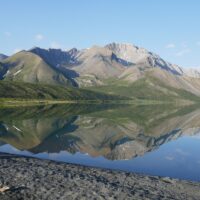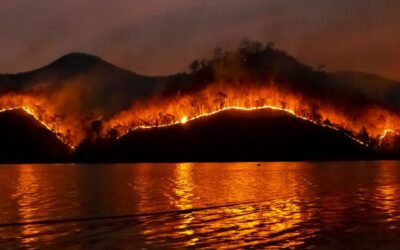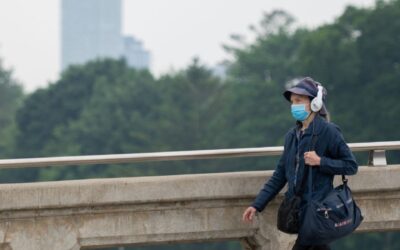The Climate Institute recently released The Health Costs of Climate Change: How Canada Can Adapt, Prepare, and Save Lives. The report details the rising costs to healthcare and the economy as climate change gets worse. Yet it also acknowledges that a lot of climate impacts are difficult, sometimes impossible, to cost—and that the mental health impacts may be among the most damaging.
To better understand the current and future impacts of climate change on mental wellness, I spoke with Dr. Ashlee Cunsolo, health geographer and founding Dean of the School of Arctic and Subarctic Studies at the Labrador Institute of Memorial University. For over a decade, Ashlee has been working with Inuit communities in Northern Labrador and studying the impacts of climate change on mental health and wellness.
In our conversation, Ashlee spoke with urgency of the toll that climate change is having on mental health, particularly in parts of the world that have already been grappling with the effects of a rapidly warming climate such as Labrador, where she now lives and works. She also spoke about the ways in which the intangible losses and damage from climate change are often overlooked and understudied but can have negative and widespread impacts on individuals and communities.
How did you come to work at the intersection of climate change and mental health?
I was just starting my PhD at the University of Guelph, and at the time my close colleague, Dr. Sherilee Harper (currently at the University of Alberta), was beginning to work with the community of Rigolet, Nunatsiavut, on health linkages with weather, climate, and water quality. I had an opportunity to join the team, which was led by Inuit in Rigolet and the Town Council, to work with the community to learn about how climate change was impacting health and wellbeing. As part of this work, we received funding from Health Canada to set up a permanent research and digital media lab in the community, where Inuit in the community did different types of research, from water quality monitoring, to interviews, to digital stories and film.
Climate change and mental health wasn’t a direct focus of my research when we first started. But after two years of working closely with the community, interviewing over 80 people from ages 9 to over 80 and having really in-depth discussions, often multiple times with the same people, I found that one hundred per cent of the interviewees—no matter the person’s age, gender identity, what they did, or how much time they spent out on the land—identified some aspect of mental and emotional health and wellbeing as a concern.
This became the focus of my research working with the community, and has continued to be my central research interest since 2009, both working in Labrador and more broadly, including the production of a documentary film on the topic, Attutauniujuk Nunami/Lament for the Land.
The last decade has seen increasing focus on the mental health impacts of climate change as more and more people are experiencing direct or indirect effects on their mental health and wellbeing.
In 2016, I moved to Labrador full time to first become Director of the Labrador Institute of Memorial University, and now Dean of the newly formed School of Arctic and Subarctic Studies in Happy Valley-Goose Bay, Labrador. Living in Labrador full time, continuing with this research, and connecting with people daily, I’m finding the topic of climate change is often at the forefront of people’s minds.
This past winter, for example, was record-breaking on every level—warm temperatures, snow amounts, lack of ice. In Labrador, people are already living the acute impacts of climate change. When people say, “well, climate change and mental health are in the future, that’s what could come,” for people here, climate change is already a reality and has been for quite some time. Decision makers and people living in other regions often see climate change as a future problem, but for those who are on the front lines, not only in the North, but around the world, this is a now problem.
For people on the front lines, climate change is a now problem.
How is this suffering experienced? What does the impact on people’s wellness look like?
Well, there’s a whole area to consider around intangible loss and damage. How do you put a cost to cultural erosion or degradation or loss? How do you put a cost to language alteration, or people spending less time on the land? I mean, we’re talking about people’s identity. We’re talking about cultures that have lived on and moved through certain landscapes for thousands and thousands of years and are suddenly, now, unable to travel or hunt or connect in ways that were previously possible.
As one of the leaders in Nain, Nunatsiavut, with whom we worked said in Attutauniujuk Nunami/Lament for the Land, “Inuit are people of the sea ice. If there’s no more sea ice, how do you be people of the sea ice?” We are talking about things that are deeply personal, deeply existential, and deeply disorienting. You can’t put a cost to these things. The economic-costs-of-climate-change framework shows only a glimpse of the overall impacts.
I’ve heard similar experiences shared by other Indigenous, Black, and racialized people around the world who disproportionately face climate impacts. Many find that climate research focused on economic costs alone is too narrow and doesn’t capture the needs and lived experiences of people on the frontlines. How can we address these gaps?
A lot of how we talk about climate change looks at climate devoid from human responsibility, devoid from settler colonialism and global capitalism. A lot of the climate literature is very much still white-centred scholarship. There’s this whole absence of other people and other ways of knowing in climate dialogues.
When we talk about climate change, we’re really talking about the outputs of a global capitalist system premised on settler colonialism and resource extraction. What’s hiding under climate change that we never talk about, and who does that silence protect?
Can you speak to the different types of ecological grief and the range of mental and emotional challenges experienced by people facing different climate change impacts?
Ecological grief falls into four categories. First is grief from acute disasters. This is the type that we understand best: after hurricanes, landslides, wildfires, or flooding, there are high rates of PTSD, long-term anxiety, long-term depression, and these continue for years to come. Even 10, 20 years later, some people still face a significant impact on mental health.
Second, grief from slow-onset changes, like loss of ice or shifts in environmental conditions over time, is another way in which people experience ecological grief. This type of grief is slow, creeping, and harder to identify or pinpoint. How do you measure something that, day by day, is incrementally wearing people down? People aren’t always able to articulate it, because you can’t point to one major break event; there’s just a generalized sense of stress, anxiety, sadness.
Robert Nixon calls these slow, incremental changes slow violence, or the slow change to the natural environment from climate change, extraction, urban growth, loss of species, loss of beloved place, changing ecosystems, changing sense of self in place, changing connection to land, more desertification in some places, more drought, sea level rise in low island states. It’s day by day, year by year.
The third category is vicarious grief, where people see others suffering or hear the news or see the disasters. An example was the Australian wildfires of 2020, when the whole world watched this devastating disruption. The outpouring of grief from people who were very far away was very palpable.
Finally, anticipatory grief is the grief and anxiety from thinking about what’s to come. For people who are on the front lines, it can be quite acute because you know what you’re experiencing already, and then it’s very easy to project out. For others, it’s thinking about climate change more generally, and is often linked to eco-anxiety or climate anxiety.
If you think about Labrador, people are already experiencing really, really hard times with climate change. Some measurements indicate warming of 2 to 3 degrees Celsius already, with projections of an average annual temperature shift of 9 to 11 degrees by 2100. People know what that means, and how that will alter ice conditions, wildlife and plant patterns, and ways of life. It’s unfathomable in some ways, and that creates various forms of chronic grief and anticipatory grief, thinking about the future and the impacts on oneself and one’s family, community, and culture.
For people who aren’t living on the front lines, anticipatory grief is still based on knowing what’s coming, and thinking about future loss. A tomorrow with loss—what does that mean? How do we make sense of that? What will happen? What sort of future are we facing? How much suffering of humans and non-humans will occur? These are enormous questions, which are often grief- and anxiety-ridden.
So what can be done to address this mental health crisis?
People’s mental health needs are so complex, and we need diverse responses, at multiple levels. We need formalized healthcare, enhanced therapy, and counselling options that understand the ways in which climate change impacts mental health. We need to fund the tremendous work that communities are doing to create resources and supports that are relevant to their cultures and priorities. We need culturally relevant mental healthcare, such as land-based programming. We need more nature-based therapies. We need more green infrastructure and community planning and design that promotes active transportation and healthy living, as well as environmental sustainability. There are some great resources and networks already available. (See the list below.)
Therapy can be really important at certain stages. But there’s so much more that’s been coming up, from all different cultural perspectives. It includes more on-the-land programming, talking circles—the Good Grief Network has emerged online. Mental health support in general is completely underfunded and overstretched. In rural and remote areas, Indigenous-specific mental health resources are virtually absent.
The government has to take a multifaceted approach. People’s mental health needs are so complex. We need formalized healthcare, and then we need to fund the tremendous work that communities are doing to create resources and supports that are relevant to their cultures and priorities.
What I’ve seen work very well in the North is when people have access to culturally appropriate mental health counselling and on-the-land programming and sports and activity nights. It’s not one thing or another, it’s all of it together.
This interview has been edited and condensed.
If you are struggling with any of the challenges described here, please reach out to someone you trust. Here are some additional resources that may be of help:
- Resources for Youth by Climate Psychology Alliance
- EAS Solutions’ Eco-Anxious Stories
- Gen Dread Newsletter by Britt Wray
- Is This How You Feel?
- The Good Grief Network
Ashlee Cunsolo, PhD, is a health geographer and the founding Dean of the School of Arctic and Subarctic Studies in the Labrador Institute of Memorial University.
Kiemia Rezagian is a climate action advocate and equitable community builder based in the territory of the Three Fires Confederacy.







